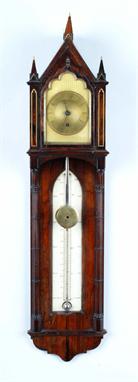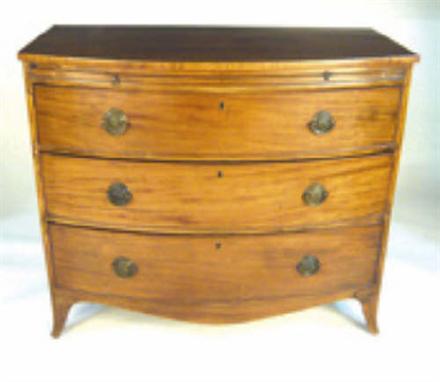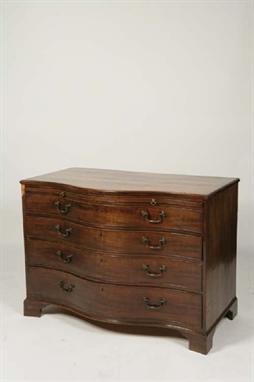A selection of brass longcase, table and bracket clock case mount castings, 17th/18th century design, late 20th century. Including a set of early pattern Corinthian column, festoon swag and other longcase hood mounts; Knibb and Tompion pattern table clock mounts and small quantity of other related items. Provenance: The Workshop of John Hooper. Visit www.dnfa.com for condition reports.
We found 177913 price guide item(s) matching your search
There are 177913 lots that match your search criteria. Subscribe now to get instant access to the full price guide service.
Click here to subscribe- List
- Grid
-
177913 item(s)/page
A black marble and bronze garden sundial, James Smith, dated 1864. The square plate with raised moulded circular section engraved with radiating lines and Roman numeral chapters and signed JAMES SMITH, 1864 at the base of the angled pieced bronze gnomen 31cm wide, with an unusual wall mounting sundial with gnomon opposing angled semi-circular scale with mounting bracket to rear, 32cm wide, both with minor damage. Provenance: The Workshop of John Hooper. Visit www.dnfa.com for condition reports.
A George III mahogany eight-day longcase clock, Barker, Wigan, circa 1780. The four-pillar rack and bell striking movement with sprung trip-repeat lever and 13 inch brass break-arch dial with calendar aperture and subsidiary seconds dial to the matted centre within an applied silvered Roman numeral chapter ring with Arabic five minutes and winged cherubs head and foliate scroll cast spandrels to angles, the arch with circular silvered boss signed Barker, Wigan flanked by dolphin cast mounts, the swan-neck pedimented case with carved rosette terminals above well turned columns to hood, shaped-top triple line bordered and crossbanded door flanked by quarter columns to trunk, on raised shaped-panel fronted plinth base with canted angles and ogee bracket feet, 128cm high. Probably made by the father and son partnership William and Daye Barker who are recorded in Loomes, Brian LANCASHIRE CLOCKS and CLOCKMAKERS as working from Wigan up to 1787. The above description should be read in conjunction with IMPORTANT NOTES REGARDING THE CATALOGUING OF CLOCKS printed in the sale catalogue. Visit www.dnfa.com for condition reports.
A Victorian ebonised quarter chiming bracket clock, W. Thornhill & Co, London, late 19th century. The substantial four-pillar triple fusee movement chiming the quarters on a nest of eight bells and striking the hour on a gong, the 8.5 inch brass break-arch dial with oval silvered plaque signed W. Thornhill & Co., 144 New Bond St, London to the matted centre within an applied silvered Roman numeral chapter ring with stylised fleur de lys half hour markers and Arabic five minutes, the angles with cherub head and scroll spandrels beneath CAMBRIDGE/WESTMINSTER chime selection and CHIME/SILENT dials within conforming mounts to arch, the break-arch case with central platform upstand and five brass vase finials above female caryatid mounted front angles and scroll cast and pierced side frets, on moulded base with foliate cast bracket feet, 68cm high. The above description should be read in conjunction with IMPORTANT NOTES REGARDING THE CATALOGUING OF CLOCKS printed in the sale catalogue. Visit www.dnfa.com for condition reports.
A mahogany eight-day longcase clock, Thomas Humber, Bristol, 18th/19th century. The four-pillar rack and bell striking movement with 12 inch brass break-arch dial with scroll engraved calendar aperture and subsidiary seconds dial to the matted centre within an applied Roman numeral chapter ring with fleur de lys half hour markers and Arabic five minutes, the angles with bird and urn pattern spandrels beneath silvered boss signed Thos. Humber, Bristol between dolphin cast mounts to arch, now in a parquetry banded arch-top case with shaped crest above fluted pilasters and wavy-edge door to hood, short trunk door flanked by quarter columns, on tall plinth base with bracket feet, 215cm high. The above description should be read in conjunction with IMPORTANT NOTES REGARDING THE CATALOGUING OF CLOCKS printed in the sale catalogue. Visit www.dnfa.com for condition reports.
An eight-day longcase clock with penny moon, John Cooper, Whitchurch, 18th century. The substantial four finned-pillar rack and bell striking movement with 12 inch square brass dial with foliate engraved calendar aperture, ringed winding holes and penny moon within the subsidiary seconds dial to the matted centre, the applied silvered Roman numeral chapter ring with foliate half hour markers, Arabic five minutes and signed Jo: Cooper, Whitchurch to lower edge, the angles with female mask and scroll cast spandrels, now in a walnut case with moulded cornice above integral pilasters and 12.75 inch aperture (now fitted with a brass mask for the current dial) to hood, crossbanded break-arch door to trunk, on plain plinth base with ogee bracket feet, 218cm high. The above description should be read in conjunction with IMPORTANT NOTES REGARDING THE CATALOGUING OF CLOCKS printed in the sale catalogue. Visit www.dnfa.com for condition reports.
An Irish George III inlaid mahogany eight-day longcase clock, Shaw Williamson, Dublin early 19th century. The four-pillar rack and bell striking movement with 13 inch square white painted Roman numeral dial with subsidiary seconds dial and bearing signature SHAW WILLIAMSON, DUBLIN to centre, with Arabic five minutes and flowering fruit painted spandrels, the case with broken triangular pediment and cavetto cornice above fluted pilasters flanking dial to hood, short shaped-top door flanked by quarter columns with line outline panel beneath to trunk, on crossbanded and line bordered flame panel fronted plinth base with bracket feet, dial retouched, 221cm high. The above description should be read in conjunction with IMPORTANT NOTES REGARDING THE CATALOGUING OF CLOCKS printed in the sale catalogue. Visit www.dnfa.com for condition reports.
A fine Irish George III mahogany eight-day longcase clock, David Gordon, Dublin, circa 1750. The four-pillar inside countwheel bell-striking movement with 13.5 inch square brass dial with ringed winding holes, subsidiary seconds dial, blanked-off calendar aperture, and ribbon shaped nameplate signed David Gordon DUBLIN to the matted centre, within an applied Roman numeral chapter ring with Arabic five minutes, the angles with cherub head and foliate scroll cast spandrels, the case with scallop-shell centred swan neck pediment and lion's mask centred foliate scroll carved swollen frieze above stop-fluted Corinthian pilasters to the hood, the trunk with convex throat moulding and long break-arch door flanked by canted angles, on raised panel-fronted plinth base with bracket feet, some old repairs, 224cm high. David Gordon is recorded in Fennell, Geraldine A LIST OF IRISH CLOCK MAKERS as working in Dublin 1739-55. The current lot is almost identical to an example by Alexander Gordon supplied to John Corry for Castle Coole, Co. Fermanagh in 1748, illustrated in The Knight of Glin and Peill, James IRISH FURNITURE, page 256. The above description should be read in conjunction with IMPORTANT NOTES REGARDING THE CATALOGUING OF CLOCKS printed in the sale catalogue. Visit www.dnfa.com for condition reports.
A fine and rare first period brass lantern clock, unsigned, circa 1635. The short-duration posted countwheel bell- striking movement formerly with verge and balance-wheel escapement now with verge and external short bob pendulum (swinging to the left hand side of the clock), with external alarm to the iron backplate, the dial with alarm disc within winged angel mask and alternating thistle-and-flower foliate trail engraved centre with original iron arrowhead hand and applied narrow Roman numeral chapter ring with asterisk half hour markers, the corners decorated with leafy-spray infill, the frame with heraldic frets and cup-and-cover turned finials beneath domed bell bearer and conforming finial, with later pointed-arch glazed brass side doors, on inverted acorn feet, 42cm high, with a carved oak wall bracket. This rare early London-style clock can be stylistically dated to the 1630s and loosely compared to examples by makers such as Peter Closon, William Sellwood and Francis Foreman. However the winged angel mask engraved motif to the dial centre is reminiscent of clocks from a slightly earlier period (see Loomes, Brian Lantern Clocks & Their Makers pages 50-51). The thistle decoration is also unusual and suggests a tantalising possibility that the clock could have Scottish origins, indeed the frame castings and general design are related to the work of Humphrey Mills of Edinburgh (op. cit. pages 331-333). However as it appears that Mills never incorporated alarms into his clocks, the current lot is unlikely to have come from his workshop. The conversion from balance to short pendulum regulation was done early in the clock's life and in such a way as to enable the retention of the alarm mechanism which was often removed during such conversions (to allow for the pendulum to be placed at the rear of the clock). The above description should be read in conjunction with IMPORTANT NOTES REGARDING THE CATALOGUING OF CLOCKS printed in the sale catalogue. Visit www.dnfa.com for condition reports.
An early Victorian mahogany small bracket timepiece, unsigned, mid 19th century. The four-pillar single fusee movement with anchor escapement and square silvered Roman numeral dial set within a mask with re-entrant corners, the case with button finial to the radial gadroon carved top above fluted frieze and canted front angles, the base with moulded waist and stepped plinth with bun feet, 34cm high. The above description should be read in conjunction with IMPORTANT NOTES REGARDING THE CATALOGUING OF CLOCKS printed in the sale catalogue. Visit www.dnfa.com for condition reports.
An unusual Regency Gothic revival brass inlaid rosewood wall-mounted small bracket timepiece with thermometer, Payne, London, early 19th century. The single fusee movement with anchor escapement and Vulliamy type suspension to the steel rod pendulum with circular bob, the shaped backplate signed Payne, 163 New Bond Street, the engine-turned gilt Roman numeral shaped-arch dial in gabled case with three spire finials above Gothic arch inlaid pilasters flanking dial, with pendant finials and brackets fronting the lower backboard inset with an ivory scaled pointed arch mercury thermometer flanked by cluster columns, 67cm high. William Payne is recorded as working in London from 1811, the firm continued as Payne and worked from 1856 until circa 1875. The above description should be read in conjunction with IMPORTANT NOTES REGARDING THE CATALOGUING OF CLOCKS printed in the sale catalogue. Visit www.dnfa.com for condition reports.
A George III mahogany eight-day longcase clock, Jacob Heardman, London. The five-pillar rack and bell striking movement with 12 inch brass break-arch dial with subsidiary seconds dial and calendar aperture to the matted centre, within an applied silvered Roman numeral chapter ring with Arabic five minutes, the angles with bird and urn pattern spandrels beneath silvered boss signed Jacob Heardman, London flanked by dolphin cast mounts to arch, in a case with break-arch cornice and reeded Corinthian pilasters to hood above break-arch door flanked by fluted canted angles to trunk, the conforming plinth with shaped panel to front on double skirt base incorporating bracket feet with shaped apron between, 214cm high. The above description should be read in conjunction with IMPORTANT NOTES REGARDING THE CATALOGUING OF CLOCKS printed in the sale catalogue. Visit www.dnfa.com for condition reports.
A fne George III mahogany bracket clock, George Tomkins, London, late 18th century. The five-pillar rack and bell striking twin fusee movement with verge escapement and border engraved backplate, the 7 inch single-sheet silvered brass Roman numeral break-arch dial with calendar aperture and signed George Tomkins London to the centre, the arch with subsidiary STRIKE/SILENT dial, the figured mahogany bell-top case of fine colour with brass handle and pineapple finials above circular and concave-topped rectangular brass fishscale frets to sides, on moulded base with brass ogee bracket feet, 47cm high excluding handle. The above description should be read in conjunction with IMPORTANT NOTES REGARDING THE CATALOGUING OF CLOCKS printed in the sale catalogue. Visit www.dnfa.com for condition reports.
A George III mahogany table clock, John Waldron, London, circa 1760. The five-pillar twin fusee bell-striking movement with verge escapement, hour trip-repeat and delicate foliate-scroll engraved backplate, the 8 inch square single-sheet silvered Roman numeral dial (viewed through a brass-bezel lined 7.5 inch circular aperture to the front door) with calendar aperture, blued steel hands and signed John Waldron, Cornhill, London to centre, with Arabic five minutes and Strike/Silent switch at 12 o'clock, the mahogany bell top case with brass carrying handle above circular brass-bezel applied quarter veneered front door and rectangular side windows, on mounded base with brass ogee bracket feet, 43cm high excluding handle. Provenance: The property of a private collector. John Waldron is recorded as working in Cornhill 1765-82. The design of the current lot with the circular aperture in the front door only revealing the central section of the square dial was first introduced by John Ellicott in around 1760. The above description should be read in conjunction with IMPORTANT NOTES REGARDING THE CATALOGUING OF CLOCKS printed in the sale catalogue. Visit www.dnfa.com for condition reports.
A fine and rare Queen Anne ebonised bracket timepiece with pull quarter repeat and alarm, Christopher Gould, London, circa 1710. The five finned pillar single fusee movement with verge escapement, silent pull repeat on two bells and alarm, the foliate engraved backplate with external blued steel and brass ratchet-and-clicks for the spring barrel and signed CHR GOULD LONDINI Fecit within an elaborate shaped cartouche surmounted by an eagle, the 7 inch square brass dial with ringed winding hole, silvered alarm disc, fine pierced blued steel hands and herringbone-bordered false bob aperture further signed Chr. Gould, London to the matted centre, within an applied silvered Roman numeral chapter ring with stylised sword hilt half hour markers and Arabic five minutes, the angles with winged cherub head spandrels with foliate scroll engraved decorative infill between, the case with foliate cast handle to the inverted bell top with brass vase finials above fine foliate scroll pierced and chased gilt brass repousse overlaid rectangular side windows, on moulded base with brass disc feet, 36cm high excluding handle. Christopher Gould is generally regarded as one of the leading makers from the 'Golden Period' of English clockmaking. He was made Free of the Clockmakers' Company in 1682 but by 1713 had become destitute and received charity from the Company until his death in 1718. Christopher Gould's work invariably demonstrates a level of quality and elaboration that could only be afforded by the most wealthy of patrons. The current lot is no exception as the specification, with combination of silent pull quarter repeat and alarm, indicates that it was designed for bedroom use, suggesting that it was originally supplied to a very wealthy individual who was able to afford a clock reserved exclusively for the bed chamber. Provenance: Acquired by Alfred Loader (Greiner) circa 1910, thence by descent. (Full provenance available in the printed catalogue). The above description should be read in conjunction with IMPORTANT NOTES REGARDING THE CATALOGUING OF CLOCKS printed in the sale catalogue. Visit www.dnfa.com for condition reports.
A fine small George III ebonised bracket clock, Thomas Grignion, London, circa 1775. The six-pillar twin fusee rack and bell striking movement with verge escapement, rise-fall regulation and signed Thomas Grignion, Covent Garden, London to the finely engraved foliate scroll decorated backplate, the 5 inch single-sheet silvered brass Roman numeral break-arch dial with calendar and false bob apertures to centre beneath subsidiary regulation and STRIKE/SILENT dials to arch with recessed shaped signature plaque Tho.s. Grignion Covent Garden, LONDON above, the bell-top case with hinged brass carrying handle and brass ball finials above break-arch side windows and finely pierced fret infill to angles above dial, on brass ball feet, 36cm high excluding handle. Thomas Grignion was born in 1713. He worked in partnership with his father (who was previously employed in the workshop of Daniel Quare) from circa 1730 to 1750, continuing the business alone until 1775 when he went into partnership with his son, also named Thomas, until his death in 1784. Provenance: Acquired by Alfred Loader (Greiner) circa 1910, thence by descent. (Full provenance available in the printed catalogue). The above description should be read in conjunction with IMPORTANT NOTES REGARDING THE CATALOGUING OF CLOCKS printed in the sale catalogue. Visit www.dnfa.com for condition reports.
George III cross and feather banded walnut tallboy, the upper section of three short and three long graduated drawers, having fluted canted corners, the lower section with brushing slide above three further graduated drawers, the lower one having central concave inlaid sunburst decoration, raised on bracket feet, w. 105 cm
-
177913 item(s)/page



















































